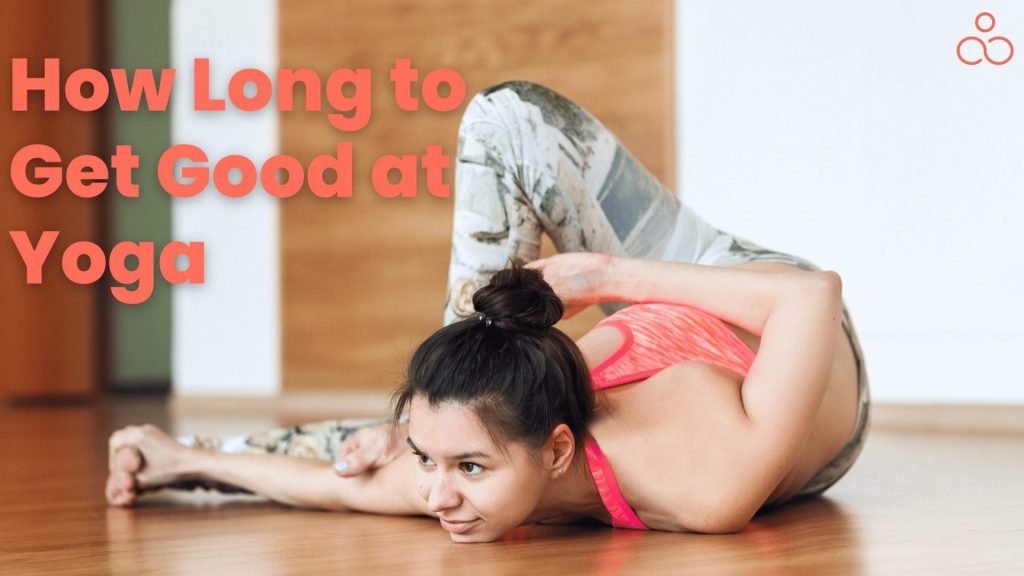When you look at the skilled Yogis and Yoginis doing challenging poses swiftly without letting out a sigh, do you find yourself asking this question: “How long to get good at Yoga like them? Truth be told, there’s no one-size-fits-all answer.
However, in this article, we’ll discuss the time commitment, the factors influencing one’s progress in Yoga, the beneficial effects of Yoga for our well-being, some amazing Yoga poses to enhance your Yoga practice along with some Yoga tips for beginners.
So unroll your mat, take a deep breath, and let’s dive into this article to discover the answer to “How long does it take to get good at Yoga”.
How long to get good at Yoga?
Many beginners ask “How long does it take to get really good at Yoga?”. The truth is, there’s no clear answer, as the purpose of Yoga goes beyond physical improvement.
Classic Yoga scriptures suggest that true mastery comes from a deep spiritual connection. However, physical and mental benefits can be experienced within the first few weeks of regular practice, with significant changes often visible within 3 to 6 months.
Being “good” at Yoga isn’t just about flexibility, strength, or advanced poses. Instead, it involves emotional control, compassion, self-awareness, and moderation in daily life. Focusing on these aspects can lead to decreased stress, increased happiness, and improved mental health.
Even short daily Yoga sessions can bring more benefits than longer infrequent ones. To achieve fast results, maintain consistency and incorporate a holistic approach that includes proper breathing and meditation techniques along with yogic dietary principles.
It’s difficult to predict each individual’s improvement timeline due to various factors such as age, fitness level, and genetics. However, dedication and persistence can eventually lead to notable changes in both physical and mental health.
Practicing Yoga three to four times a week for an hour, combining intense and relaxed styles, will lead to results like:
- Enhanced strength in 5-6 weeks, with quicker results for weaker muscles. Expect better core and hip strength than the upper body.
- Improved flexibility within 3-4 weeks, making poses easier and more comfortable, like Downward Facing Dog and front splits.
- Weight loss in 5-6 weeks if you maintain a good diet and stay active in your daily life.
- Better balance in 5-6 weeks, improving poses like Tree, Warrior III, and Standing Knee to Chest as core strength and joint stability increase.
How long does it take to get in shape with Yoga?
Yoga offers more than just a calming “om” – it can also help you stay fit. The time it takes to see physical improvements depends on your starting point, goals, and practice details.
Different Yoga styles cater to various body benefits. For example, Ashtanga and Vinyasa provide an intense workout, improving strength and endurance. On the other hand, slower-paced styles like Yin and restorative Yoga help relax muscles, reduce stress, and enhance flexibility.
Regardless of the style, most Yoga practices can improve mental and emotional well-being. A 2017 review of 23 studies in the Journal of Evidence-Based Complementary and Alternative Medicine found that Yoga effectively reduced depression symptoms.
What are the Benefits of Practicing Yoga?
Become More Flexible With Yoga
Yoga offers stress relief and increased flexibility. Many poses stretch muscles and boost motion range. Gradually, consistent Yoga can enhance flexibility. You may feel limber after one session, but lasting improvements take around eight weeks, says certified trainer and Yoga instructor Stephanie Thomas.
For optimum flexibility, do four 20-minute Yoga sessions weekly. While all Yoga styles help, Thomas prefers Yin Yoga because it requires holding poses for longer durations.
Yoga to Make You Stronger
The Department of Health and Human Services (HHS) advises Americans to perform strength-training exercises for all major muscle groups twice a week for optimal health. While gentle Yoga might not count, more strenuous Yoga practices with strength-building poses can help achieve a toned body.
Hatha Yoga, though slower, can also improve strength. A 2015 study in the International Journal of Yoga showed that 12 weeks of Hatha Yoga enhanced handgrip and leg strength for Indian Air Force volunteers. Yoga poses use isometric contractions to challenge muscles by holding the body in a fixed position without changing the muscle length or visibly moving joints.
Isometric exercises don’t improve speed or athletic performance, but they do enhance joint stability, making daily activities and exercise safer and preventing injuries. To build strength in Yoga, practice poses like plank pose, Chaturanga (Yoga push-up), Navasana (boat pose), Utkatasana (chair pose), Utthita Parsvakonasana (extended side angle), and warrior poses. You may find challenging poses becoming easier within weeks; however, initial results come from your body’s neural adaptations rather than actual strength increases.
Balance Gentle Yoga With Strength Training
For gentler restorative Yoga styles, include additional exercises for full strength-training benefits. Try gym weight-training circuits, boot camp classes, or suspension training. Strength training offers stronger muscles, and bones, reduced chronic symptoms, improved life quality, and better cognition.
Easily combine Yoga and strength training by adding a short 10-15 minute Yoga session before or after your workout. Pre-workout Yoga warms up muscles while post-workout helps cool down. Adjust practice time as needed.
Yoga Results for Weight Loss
If you’re doing Yoga for weight loss, it’s hard to determine the exact calorie burns for different Yoga styles since they vary in intensity. For example, Harvard Health estimates that Hatha Yoga, a gentle style, burns around 240-356 calories per hour, similar to walking at 3.5 mph. More active Yoga styles like Vinyasa, power, or Ashtanga might burn more.
Creating a calorie deficit is key to losing weight, but the process is complex. Yoga can promote healthy behaviors, as shown by a 2018 study in the International Journal of Behavioral Nutrition and Physical Activity. Participants ate more fruits and vegetables and exercised more while consuming less fast food and sugary drinks.
A 2016 study in Evidence-Based Complementary and Alternative Medicine observed 20 women who lost weight through Yoga, identifying healthy eating habits and support from the Yoga community as key factors.
Yoga can aid weight loss mainly through mental benefits rather than physical ones. Remember, weight loss with just Yoga may be slower compared to cardio and weight lifting, which burn more calories and add variety to your exercise routine.
Yoga for Body Transformation
Wondering how long it takes for Yoga to help shed extra body fat? The Centers for Disease Control and Prevention suggest losing 1 to 2 pounds per week for long-lasting results. This is a great goal, regardless of your Yoga practice.
If your weight loss isn’t consistent, focus on Yoga rather than stress. Some people see quicker results at the beginning of their weight-loss journey, while others take a few weeks to find the right mix of exercise, nutrition, and self-care to not only lose weight but maintain it in the long run.
Doing Heart-Healthy Yoga
Getting in shape also means boosting your heart health. The HSS suggests at least 150 minutes of moderate or 75 minutes of vigorous aerobic activity per week. More active Yoga like Vinyasa counts toward moderate intensity.
A 2018 study in the International Journal of Environmental Research and Public Health examined 13 inactive individuals doing HIIT and continuous-intensity exercise. Both groups improved cardiac function after two weeks, but HIIT showed more benefits. Any movement is good for you.
Usually, cardiovascular health studies last for 12 weeks or more. But with consistent Yoga practice, you might find workouts easier within a few weeks. However, it’s crucial to combine gentler Yoga with other exercises like walking, swimming, cycling, or group dance classes to meet HHS guidelines and stay fit outside the Yoga studio.
A Step-by-Step Guide to Yoga for Beginners
New to Yoga? Don’t worry about complex poses. Start with basic postures to build core strength and flexibility. There are many Yoga styles for different needs. For a quick workout, try power Yoga. For an intense, sweat-inducing session, go for hot Yoga. Hatha Yoga is perfect for beginners due to its slow pace and easy postures. Vinyasa links your mind and breath with active stretching for body conditioning. Explore these and other Yoga styles to enhance flexibility, athletic skills, and mental focus.
Before diving into fundamental poses, let’s discuss why practicing any form of Yoga is beneficial.
Relieve stress
We all cope with stress differently. However, it is believed that intense gym workouts or boxing can make you angrier or more exhausted. Instead, Yoga uses various relaxation methods that can calm you down when practiced regularly.
Yoga not only trains your body but also helps your mind focus on the big picture and act responsibly instead of panicking. To be more like James Bond than Charlie Sheen, hit the Yoga mat. It’s also beneficial to disconnect from texts, calls, and emails for 60 to 90 minutes.
Get flexible
Yoga asanas often feature spinal twists to help loosen your spine’s many joints. These twists can enhance your tennis and golf skills, while also supporting detoxification and healthy digestion. Yogi Cameron Alborizan, an Ayurvedic healer, Yoga expert, and author of The One Plan, compares the body to a dirty sponge. Gentle twists aid in wringing out this sponge and eliminating toxins.
Build more muscle
Yoga enhances flexibility and activates more muscle fibers, leading to improved muscle growth, says certified trainer and Yoga instructor Kate Abate. Muscle hypertrophy, or growth at the cellular level, occurs as a result.
By incorporating Yoga into your regular weightlifting routine, you can target previously neglected muscle areas. One example is the serratus anterior, also known as the “boxer’s muscle,” found under your armpit and over your ribcage. This muscle offers shoulder stability and serves as a foundation for developing deltoids and pectorals. Strengthening your serratus anterior with Yoga can make your abs appear more defined.
Have better sex
A study in the Journal of Sexual Medicine revealed that Yoga significantly improves a woman’s intimate experiences through increased lubrication and stronger orgasms by strengthening pelvic floor muscles. For men, Yoga alleviates anxiety, enhances body awareness and confidence, and promotes hormone release that accelerates arousal and boosts blood flow to the genital area, vital for erections.
Prevent workout injuries
Yoga classes often start by encouraging you to respect your body’s unique needs and limits for the day. This self-awareness during practice helps prevent injuries during running or other sports. Additionally, flexible and well-stretched Yoga muscles recover faster after workouts or strains.
Calm your mind
Amid busy schedules, joining a Yoga class may be the perfect way for some men to unwind and breathe properly. A 2013 study revealed that Yoga can alleviate mild depression, even for those not taking antidepressants. This ancient Indian technique also aids in sleeping better and longer. Additionally, the Journal of Physical Activity and Health reported that 20 minutes of Hatha Yoga boosts brain activity more than walking or jogging on a treadmill for the same duration.
Smell better
Michael Hewitt, Sarva Yoga Academy’s founder, highlights that Yoga significantly aids in toxin removal. He mentions that regular practice surpasses cologne in terms of pheromones. Yoga class promotes toxin elimination through sweating and exhaling, ultimately leading to a fresher scent. Hewitt states that after a session, individuals feel cleaner, more self-assured, and more focused than before.
10 Essential Yoga Poses for Beginners
Yoga focuses on poses as its foundation. Learn these for regular practice.
Try these 10 poses for a full workout. Go slow, breathe, and pause if needed. Aim to hold each pose for a few breaths before moving on.
Child’s Pose
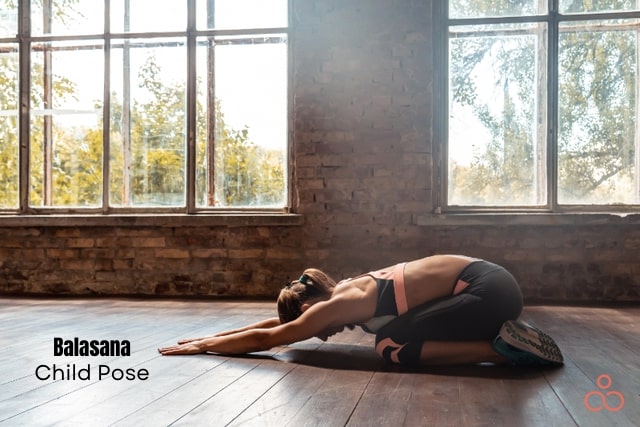
The child’s pose is a soothing default resting position. It helps you rest, refocus and prepares you for the next pose. This gentle stretch benefits your lower back, hips, thighs, knees, ankles, spine, shoulders, and neck.
- Do it: For a gentle neck, spine, and hip stretch.
- Skip it: If you have knee or ankle issues, high blood pressure, or pregnancy.
- Modify: Use a cushion or block for your head and a rolled towel for your ankles if needed.
- Be mindful: Relax your spine and lower back muscles while focusing on your breath.
Downward-Facing Dog

The downward-facing dog pose strengthens arms, shoulders, and back while stretching hamstrings, calves, and feet arches. It’s great for easing back pain.
- Do it: Alleviate back pain.
- Skip it: Avoid if you have wrist issues, high blood pressure, or are in late pregnancy stages.
- Modify: Place elbows on the ground or use blocks under your hands for extra comfort.
- Be mindful: Distribute weight evenly across palms and lift hips up and back from shoulders.
Plank Pose

The plank exercise is a popular way to strengthen your core, shoulders, arms, and legs.
- Do it: Plank is great for toning your abs and boosting your upper body strength.
- Skip it: Don’t do planks if you have carpal tunnel syndrome or wrist issues. Also, avoid or modify them if you have low back pain.
- Modify: Make it easier by placing your knees on the ground.
- Be mindful: When planking, envision your neck and spine getting longer.
Four-Limbed Staff Pose
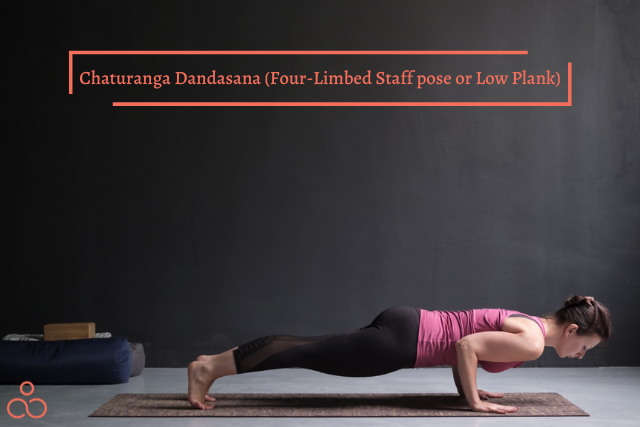
This push-up variation is a great way to prepare for more challenging Yoga poses such as arm balances or inversions. It comes after the plank pose in the sun salutation series, one of the most well-known Yoga sequences.
- Do it: Strengthen your arms, shoulders, wrists, and back, and tone your abdomen with this pose.
- Skip it: Avoid if you have carpal tunnel, lower back pain, shoulder issues, or are pregnant.
- Modify: Beginners can keep their knees on the floor for support.
- Be mindful: Keep your palms firmly on the ground and lift your shoulders as you hold the pose.
Cobra Pose
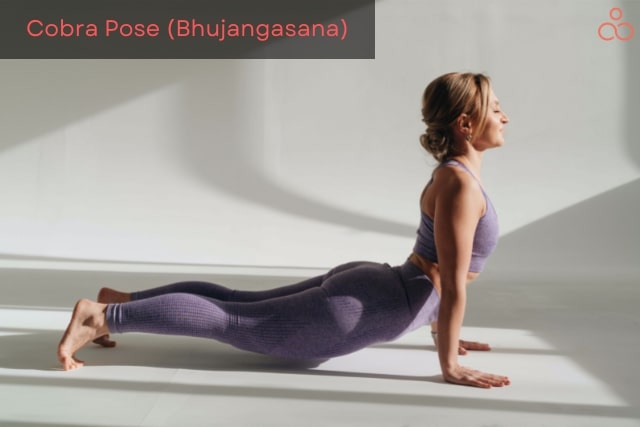
This basic back-bend strengthens back muscles, enhances spine flexibility, and stretches the chest, shoulders, and abdomen.
- Do it: Excellent for back muscle strengthening.
- Skip it: Avoid if you have spine or neck arthritis, low-back injury, or carpal tunnel syndrome.
- Modify: Lift up slightly without straightening your arms.
- Be mindful: Keep your navel away from the floor while holding this position.
Tree Pose
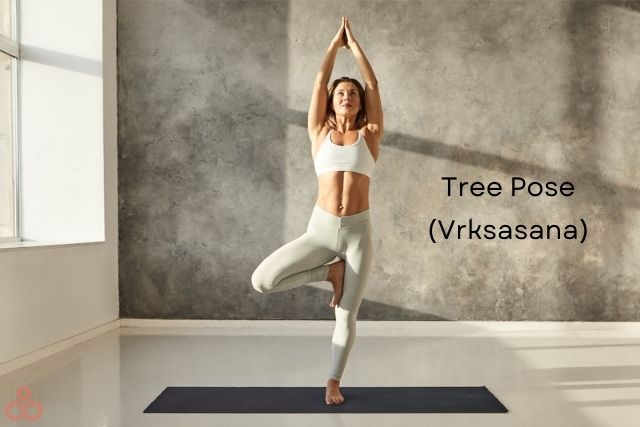
This exercise enhances balance while also strengthening your core, ankles, calves, thighs, and spine.
- Do it: Ideal for improving balance and posture.
- Skip it: Avoid this pose if you have low blood pressure or balance issues.
- Modify: Use a wall for support with one hand.
- Be mindful: Concentrate on your inhaling and exhaling while holding the pose.
Triangle Pose
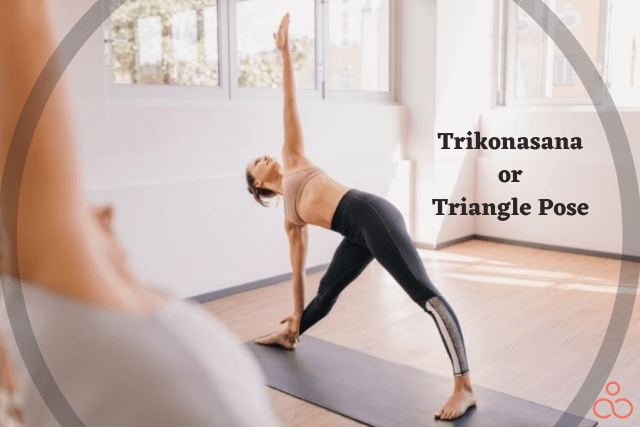
The triangle pose is a popular pose in many Yoga sequences that tones the legs, releases tension in the hips, spine, shoulders, chest, groins, calves, and hamstrings, and increases mobility in the hips and neck.
- Do it: Build strength and endurance with this pose.
- Skip it: Don’t do this pose if you have a headache/low blood pressure.
- Modify: If you have high blood pressure, look down in the final pose. For neck issues, look straight and keep your neck long.
- Be mindful: Keep raising your arm upwards to maintain the pose’s lightness.
Seated Half-Spinal Twist Pose
This twisting pose enhances back flexibility, stretches shoulders, hips, and chest, and eases mid-back tension.
- Do it: For loosening tight muscles around shoulders and upper/lower back.
- Skip it: If dealing with a back injury.
- Modify: Keep your right knee straight if bending is uncomfortable.
- Be mindful: Inhale to lift your torso, and exhale during the twist.
Bridge Pose
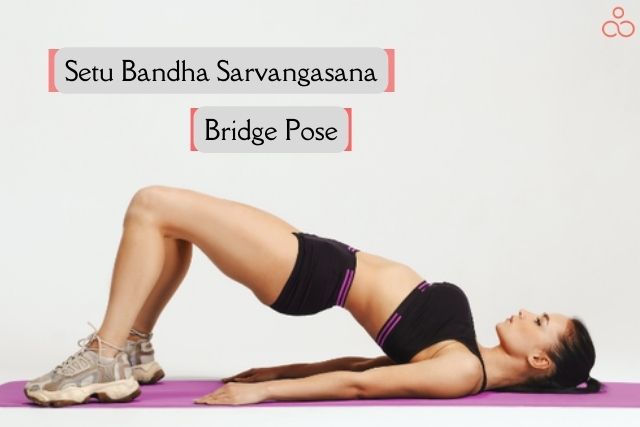
This back-bending pose stretches your chest, back, and neck muscles while strengthening your back and hamstrings.
- Do it: Perfect for those who sit all day, it opens your upper chest.
- Skip it: Don’t do this if you have a neck injury.
- Modify: Use a block between your thighs for alignment, or under your pelvis if your lower back hurts.
- Be mindful: Keep your chest up and sternum close to your chin while holding the pose.
Corpse Pose
Yoga classes often conclude with this pose, allowing for relaxation. Some may find it challenging to stay still, but with practice, it becomes easier to achieve a calm, meditative state.
- Do it: Always.
- Skip it: If you don’t seek a moment of peace.
- Modify: Use a blanket under your head or knees for added comfort and support if needed.
- Be mindful: Gradually feel your body’s weight sinking into the mat.
The 3 Best Yoga Tips for Beginners
- Stay in the back row
During your initial visits, place your mat in the back row to observe others easily. This aids learning, prevents neck strain, and offers a great view of your fellow classmates.
- Remain calm
Yoga can be challenging. Don’t worry if your athletic body hinders some poses. Progress should be gradual and consistent, and the toughest parts are often what your body needs most.
- Focus on your breathing
Yoga involves deep abdominal breathing, which activates the parasympathetic nervous system, reducing cortisol levels and belly fat. Practicing Yoga can help lower stress and cortisol in daily life.
FAQ’s
How often should I practice Yoga for results?
Most instructors suggest practicing Yoga three to five times a week for consistent improvement. A significant study on Yoga practitioners showed that those who practice at least five times a week experience optimal benefits, including overall health, sleep quality, reduced fatigue, and a sense of well-being.
When will I start to feel more flexible after doing Yoga?
With regular practice, you can usually start to feel a difference in your flexibility within two to four weeks. To get the most out of your Yoga sessions, we recommend stretching at least five days a week. Additionally, you should make sure to target different areas of your body with different stretches so that you can reap the benefits.
Can you get in shape just by doing Yoga?
Yes, absolutely! Yoga is a great way to increase muscle tone and strength. Regular Yoga will help you gain muscle, improve your flexibility, work on your posture, and keep your weight healthy. Specific poses like Downward-Facing Dog and the Warrior poses can help build strength in almost every muscle in the body.
How long for a man to get good at Yoga?
It usually takes around 3 to 6 months of consistent practice for a man to get good at Yoga, depending on individual abilities and commitment.
Is Yoga better than the gym?
If you’re looking to improve your strength, flexibility, balance, and posture, then Yoga is a great choice. If muscle-building is your priority, then the gym is the way to go. But if you really want the best of both worlds, don’t be afraid to mix it up! Consult a fitness trainer to get the best advice on forms and exercises.
What side effects can Yoga cause?
The top three reported negative impacts of Yoga include:
- Experiencing pain and soreness in limbs and lower back,
- suffering from muscle injuries like sprains, and
- feeling tired or fatigued.
Conclusion
The journey to becoming proficient in Yoga is a personal and unique experience. The time it takes to get good at Yoga practice depends on your commitment, consistency, and individual progress. Remember, Yoga is not a race but a lifelong practice of self-discovery and improvement. Embrace the process, listen to your body, and enjoy the rewarding path toward a more balanced and harmonious life.
Namaste!

